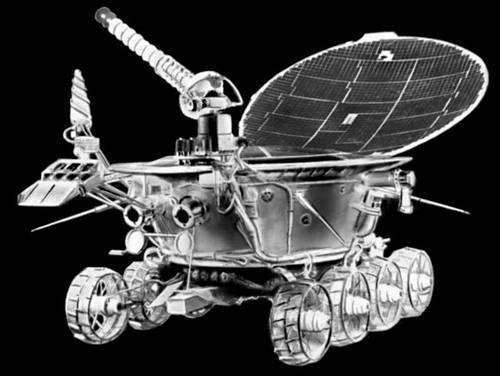Lunokhod-1. The first track on the moon

Today, on May 17, 2014, exactly forty-three and a half years passed, as on November 17, 1970, at about seven in the morning Moscow time, a group of specialists who created space technology were located in the Coordinating and Computing Center (CEC), which was under Moscow, unusual question: "In which direction to move to the surface of the moon?".
There were years of hard work of large research, design and production teams behind the Luna-17 station and the Lunokhod-1 mobile unit, which was delivered by this station to the vast lunar plateau known as the Sea of Rains. Behind were searches, calculations, projects, drawings, mock-ups and tests, continuous tests of components and systems in the inhospitable lunar conditions recreated on Earth. Finally, there was a sleepless night behind, during which the station reported on a series of critical operations and maneuvers prior to a soft landing.
And now the ladders are deployed, intended for the congress of the self-propelled apparatus on the lunar soil, the command has been given to disconnect it from the landing block. It was decided to move in the direction providing for the departure of Lunokhod-1 from the crater, on a rather gentle slope, which the station supports turned out to be. A memorable moment has arrived - the robot is waiting for the command to move.
')
At 9 hours 28 minutes "Lunokhod-1" drives off the ladders and begins an independent journey on the moon. The first track extends from the landing stage to the black precipice of the lunar horizon. The TASS report noted: “For the first time in the history of astronautics, an automatic lunar self-propelled device controlled from the Earth was delivered to the Moon and began research.”
Thus began the odyssey of the Soviet Lunokhod. On the first day, 20 meters of the way were covered. The first panoramas were filmed, a study of the physicomechanical properties and chemical composition of the lunar soil was conducted. Five Earth days worked "Lunokhod-1" before the end of the first lunar day, having covered a distance of 197 meters. Then came 14 days of cold night, during which the device was in a stationary position.
The normal thermal regime on board the Lunokhod-1 was provided by a special isotope source, which heats the gas circulating in the internal volume of the pressurized cabin. Separate scientific studies continued: the orientation of Lunokhod-1 ensured the work of the reflector for the laser location of the Moon, developed by French scientists.
But now the Sea of Rains was illuminated by the Sun, and the apparatus came to life, starting a new working day. Turned to the hot rays of the solar panel, providing battery recharging. Checking the condition of the onboard systems and scientific instruments showed that testing the cold of the moonlit night did not affect the performance of the device. He set off again.
11 lunar days and nights, 322 Earth days lasted for the Lunokhod-1 watch. Completed 10.540 meters. The surface of the moon was surveyed with an area of 80 thousand square meters. 200 telephoto panes and 20 thousand pictures were taken, covering about half a million square meters of the lunar surface. The characteristics of the physical and mechanical properties of the soil are measured at 500 points. At 25 points analyzed its chemical composition. A major contribution of Soviet science and technology to the achievement of practical cosmonautics, to the world treasury of knowledge about the outer space surrounding us, has been made.

(Panoramic shot from Lunokhod-1)
Of course, the possibilities of automatic stations in the study of the Moon and planets are not exhausted even now, when the events described here have already become the property of history. And a well-defined, important role belongs to mobile devices - planetary rovers. After all, the desire for movement as a means and method of knowing the world is generally characteristic of humanity. And the man studies the Earth and develops with the help of various vehicles. Unlike stationary landing blocks, the planetary rover allows exploring large areas at approximately equal costs for the preparation of expeditions. Finally, in the future, the exploration of the Moon and planets is difficult to imagine without vehicles intended for the transportation of astronauts and cargo, the production of construction, loading and unloading, rescue and other works. And, of course, the invaluable operating experience of Lunokhod-1 will once again be useful to developers of new, smarter, mobile and enduring systems. Therefore, humanity will always remember the first alien vehicle "Lunokhod-1", as it remembers the first ship, car, plane ...
"Lunokhod-1" transmits "11101111111100001110100011100010111001011111001000100001" and wants to continue the "Curiosity" glorious milestone in the exploration of neighboring planets.
PS Special thanks to Zelenyikot for space research education. I have read your articles excitedly for over a year. Sorry for being too emotional.
Source: https://habr.com/ru/post/222717/
All Articles